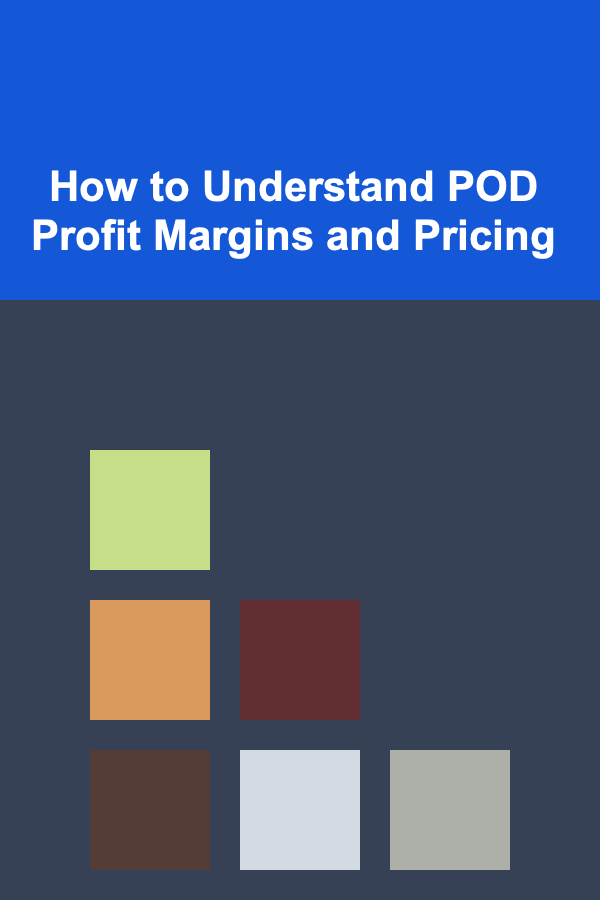
How to Understand POD Profit Margins and Pricing
ebook include PDF & Audio bundle (Micro Guide)
$12.99$6.99
Limited Time Offer! Order within the next:

Print on Demand (POD) is a model that allows entrepreneurs to sell custom products without holding inventory. It's a low-risk business model that has gained popularity, especially among creators and small businesses. However, to succeed in the POD business, understanding profit margins and pricing is critical. This article delves into how you can calculate POD profit margins and make informed pricing decisions for your products.
What Is Print on Demand (POD)?
Print on Demand is a business model where a product is printed only after an order is placed. This eliminates the need to invest in inventory upfront and reduces the risk of unsold stock. POD products can range from T-shirts, hoodies, and mugs to phone cases, posters, and even books. The product is only produced once an order is placed, and the design is usually created by the seller.
The most attractive part of POD for many entrepreneurs is that it offers a low barrier to entry, as there is no need to manage inventory or deal with shipping. You can focus on marketing and sales, while a third-party provider handles production and fulfillment. However, to turn a profit, understanding how to price your products correctly is essential.
The Basics of POD Profit Margins
What Is a Profit Margin?
A profit margin is the difference between how much you earn from selling a product and the cost of producing it. In other words, it's the money you make after all costs have been deducted. The formula for calculating the profit margin is:
Profit Margin (%) = (Selling Price - Cost of Goods Sold) / Selling Price * 100
For POD businesses, the Cost of Goods Sold (COGS) includes the production cost, shipping fees, and any other charges incurred by the POD provider. Understanding this formula is crucial because it helps you understand how much profit you will make per sale.
Key Components of POD Profit Margins
- Product Cost (Cost of Goods Sold): This is the price charged by the POD provider for printing, materials, and shipping. This cost can vary based on the product type, the printing method (screen printing, direct-to-garment, sublimation, etc.), and the quality of materials used.
- Shipping Fees: Most POD providers charge shipping fees separately, depending on the destination and shipping method. These fees are typically added to the cost of the product and will affect your overall profit margin.
- Platform Fees: If you're selling through a marketplace such as Etsy, Amazon, or Shopify, there will be additional fees associated with listing your products, transaction fees, or a monthly subscription fee. These fees should also be considered when calculating your profit margin.
- Taxes: Sales tax and other local taxes may also apply to your sales, and these can impact your pricing decisions.
How to Calculate Your POD Profit Margins
Step 1: Determine Your Product Cost
First, you need to understand the production cost of each product. This includes:
- Base price: This is the amount the POD provider charges for the product itself.
- Printing costs: The charges associated with the printing method you choose. For instance, custom designs on T-shirts will have a different printing cost depending on whether you use screen printing or digital printing.
- Shipping costs: If your POD provider charges separately for shipping, this should be factored into the cost of goods sold.
- Packaging costs: Some providers include packaging in their base price, but if they don't, you may need to account for that separately.
Step 2: Decide on Your Selling Price
Your selling price is the price you want to charge your customers for the product. This price should cover your costs and still leave you with a profit. It is also the price that your customers will see when they visit your store.
In determining your selling price, it's important to factor in:
- Market research: Look at competitors' pricing to see what similar products are selling for. Make sure your pricing is competitive but also aligns with the value you are offering.
- Perceived value: If you are offering a unique design or customization options, you may be able to charge a premium price. The perceived value of your product can influence the price customers are willing to pay.
- Profit margin goals: Determine the profit margin you aim to achieve. For example, if you want a 50% profit margin, you can calculate your selling price based on the formula discussed earlier.
Step 3: Calculate Profit Margins
Now that you know your product cost and selling price, you can calculate the profit margin using the formula:
Profit Margin = (Selling Price - Cost of Goods Sold) / Selling Price * 100
Example:
Let's say you're selling a T-shirt, and the costs are as follows:
- Product cost: $10
- Printing cost: $5
- Shipping cost: $3
- Total cost of goods sold: $18
You decide to sell the T-shirt for $30. The profit margin would be:
Profit Margin = ($30 - $18) / $30 * 100 = 40%
In this case, you'd be making a 40% profit margin on each T-shirt sold.
Step 4: Consider Other Costs
Besides the product cost and platform fees, there may be additional costs that affect your overall profitability:
- Advertising and marketing costs: If you're spending money on Facebook ads, Google ads, influencer partnerships, or other forms of advertising, those costs should be considered when calculating profit.
- Discounts and promotions: Offering discounts or running sales can affect your margins. Make sure to account for these when pricing products.
- Transaction fees: Platforms like Etsy, Amazon, and Shopify typically take a percentage of each sale as a transaction fee, so ensure that you account for this in your pricing structure.
How to Price Your POD Products
Pricing Strategies
The key to pricing POD products effectively is balancing competitive pricing with profitability. Here are several strategies to help you determine the best pricing for your products:
1. Cost-Plus Pricing
Cost-plus pricing involves adding a fixed profit margin percentage on top of your costs. It's the simplest pricing model, but it can sometimes overlook what the market is willing to pay.
Example:
- Product cost: $18
- Desired profit margin: 40%
Selling Price = $18 + ($18 * 40%) = $25.20
This pricing strategy works well for ensuring that you cover your costs and make a reasonable profit.
2. Value-Based Pricing
Value-based pricing focuses on how much customers are willing to pay based on the perceived value of your product. This is especially useful if you offer high-quality designs or premium materials.
Example:
- Base cost: $18
- Customer value: $40
With this pricing model, you could set the price at $40 based on the perceived value, even if your cost is $18. This can yield higher margins than cost-plus pricing.
3. Competitive Pricing
Competitive pricing involves setting your prices based on what competitors charge for similar products. You need to ensure that your prices are competitive enough to attract customers, but still profitable.
- Undercutting competitors: This strategy can help you attract customers looking for cheaper options, but be cautious not to erode your profits too much.
- Premium pricing: If your design or product is unique, you can charge a premium price above competitors' rates. This works best if you have a unique selling proposition (USP).
4. Psychological Pricing
Psychological pricing uses strategies that make the price appear lower than it actually is. For example, pricing your product at $29.99 instead of $30 can make it seem more affordable, even though the difference is minimal.
Testing Your Pricing
When you've settled on a price, it's a good idea to test it in the market. Monitor how customers respond to your pricing and adjust as necessary. If sales are slow, you may need to lower the price or adjust your value proposition. If sales are strong, you may be able to increase the price without losing too many customers.
Tips for Maximizing Profit Margins
- Optimize Shipping Costs: Offer free shipping if you can absorb the cost, or set a minimum order value to cover shipping fees. Free shipping can increase conversion rates and boost your sales.
- Use Upselling and Cross-Selling: Encourage customers to buy more by offering related products or upgrades. For example, if a customer buys a T-shirt, offer them a matching mug at a discount.
- Automate Your Processes: Automating order fulfillment and using efficient POD providers can reduce operational costs and allow you to focus more on marketing and sales.
- Focus on High-Margin Products: Some POD products, like phone cases, posters, and accessories, tend to have higher profit margins than others. Look for these opportunities when selecting your product line.
- Offer Customization: Personalizing products can justify higher prices and create a unique value proposition for your customers.
Conclusion
Understanding POD profit margins and pricing is crucial to running a successful business. By calculating your costs accurately, understanding the various components that contribute to your profit margin, and using effective pricing strategies, you can ensure that your POD business is profitable and sustainable.
Whether you're starting a POD business as a side hustle or building it into a full-time venture, the principles outlined here can help you make informed decisions about how to price your products and optimize your profit margins. With a strategic approach, you can create a business that not only meets market demands but also generates a steady income.

How to Create a Family Scrapbook of Seasonal Activities and Memories
Read More
How to Design a Customer Feedback Management Checklist for Increasing Customer Satisfaction
Read More
How to Leverage Robo-Advisors for Easy Investing
Read More
How to Use Online Platforms for Vintage Item Organization
Read More
How To Master Violin Vibrato and Intonation
Read More
Managing Anger: A Step-by-Step Program
Read MoreOther Products

How to Create a Family Scrapbook of Seasonal Activities and Memories
Read More
How to Design a Customer Feedback Management Checklist for Increasing Customer Satisfaction
Read More
How to Leverage Robo-Advisors for Easy Investing
Read More
How to Use Online Platforms for Vintage Item Organization
Read More
How To Master Violin Vibrato and Intonation
Read More